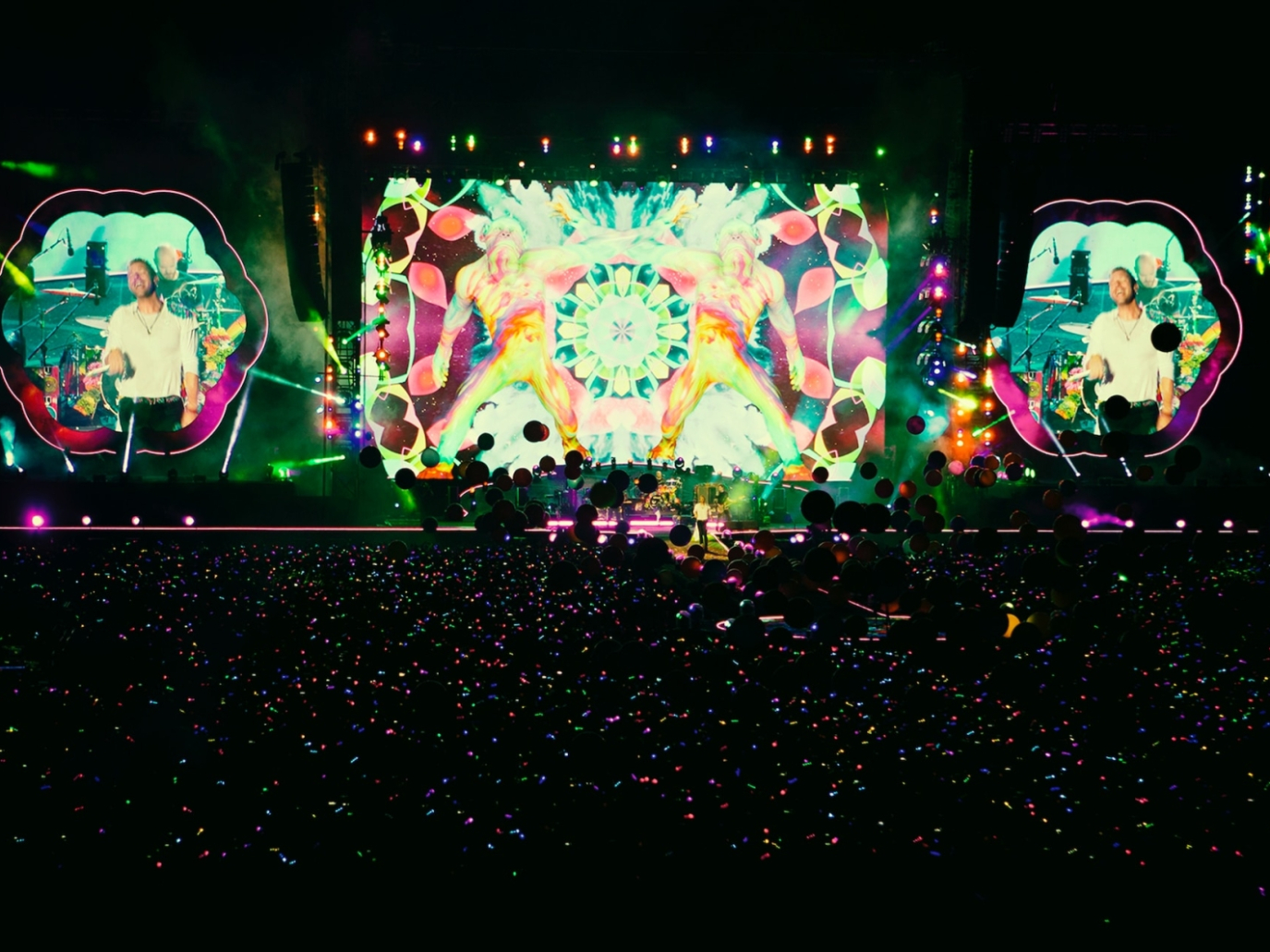Coldplay’s Music of the Spheres tour, which has dramatically reduced the band’s carbon footprint, is setting new standards of sustainability. The seventh concert tour of the British group, which began in March 2022 and will end in autumn 2023 and which has so far sold more than seven million tickets, is organized around 12 key points for sustainability including carbon dioxide emissions, electricity, water, merchandising, food and waste management.
From solar panels to LED bracelets: Coldplay’s sustainability report
Last June, the band released an updated report based on emissions data from the first twelve months of the tour, which were collected, evaluated and validated by the MIT Environmental Solutions Initiative. The musical shows have so far produced 47% fewer CO2 emissions than the previous stadium tour of 2016/2017; the energy for the production of the show (audio, lights, lasers, etc.) is provided by a system of electric batteries that uses 100% renewable energy and, on average, 86% of reusable and plant-based LED bracelets, used by the public during the show, has been returned.
On the site, where you can follow the updates on emissions, it also reads that each show has produced on average 15 kWh of energy generated by solar installations within the theater, kinetic dance floors and electric bicycles, enough to power the show on stage every night and provide the crew with charging stations for phones, laptops and utensils.
Among other measures taken, all commercial and charter flights used by production and band consume sustainable aviation fuel (SAF), the stage is built with a combination of reusable lightweight materials including recycled steel and using photovoltaic solar panels placed behind the stage, around the stadium or on the outdoor entrances to generate electricity.
At the same time, a free app was developed with SAP to raise public awareness about the use of low-emission transport to reach concert venues.
Finally, 10% of the revenue is donated by Coldplay to environmental organizations such as ClientEarth, The Ocean Cleanup, One Tree Planted, Climeworks, Sea Shepherd, Project Seagrass, Sustainable Food Trust.
Not only Coldplay: this is how the world of rock reduces the impacts of concerts
The setting up of a festival requires impressive infrastructure for scenography, design, image, sound and lighting, together with catering, safety and sanitation, cleaning and waste management, as well as communications and transport, technology centers, ticketing and customer service. A huge impact is due, of course, to the trips, by land or by air, of the lovers of live music, musicians and their entourage, including the moving sets and merchandising. Not to mention the energy needed to power, among others, sound and lighting. This complexity opens spaces for discussion and improvement on the sustainability of live performances.
Massive Attack, in 2021, working alongside Extinction Rebellion, released the Roadmap to Super Low Carbon Live Music an open tool for the music industry, commissioned and produced by the Tyndall Centre for Climate Change Research. The roadmap, which identified six key ways to reduce CO2 emissions, was tested by the band on their tour last year.
In addition to Coldplay and Massive Attack, many musicians are engaged in the realization of zero-emission shows. Some artists opt for train travel, the scenographers prefer LED displays over conventional lighting, and the promoters invite fans to carpool or take public transport to reach the places. Some music festivals have tried to group the entrance tickets with those of public transport.
Singers and bands rely on the guidance of experts who can organize sustainability initiatives to make concerts greener. One example is Reverb, a non-profit organization, which collaborates with musicians and festivals to make concert events more ecological by involving fans in taking environmental and social action. Reverb creates comprehensive programs to reduce the footprint of concerts and tours, from the elimination of disposable water bottles to the supply of food from local farms to the supply of sustainable biodiesel for tourist buses to composting and food waste donation and much more.
In addition to helping organizations and individuals set and achieve sustainability goals, since 2007, A Greener Future with the AGF certification scheme has evaluated and certified hundreds of festivals, events and venues worldwide. By providing independent audits, AGF contributes to improving resource efficiency and the environmental impact of events.
Presented a few years ago at the American Music Awards, with a shirt with the phrase "No music on a dead planet", Billie Eilish, on her tours, in addition to reducing waste and the use of plastic, offers numerous plant-based food options with reduced carbon footprint.
Pearl Jam began offsetting world tour emissions in 2003 and has since invested over $1 million in carbon credits. In 2007, Radiohead were among the pioneers in measuring its environmental impact, in addition to having donated a few years ago the proceeds of a collection of unpublished songs to the activists of Extinction Rebellion (after refusing a ransom note for the hacked files).
Since 2004 Jack Johnson has been a member of 1% for the Planet. On a recent tour Johnson has been aiming for a zero-emission show through a program of reusable glasses and water charging stations, as well as donating $2 of each ticket to CO2 compensation projects.
In December 2021, Warner, Sony, Universal and other independent record labels signed the Music Climate Pact which aims to reduce greenhouse gas emissions by 50% by 2030 and get to Net Zero in 2050.
Streaming or vinyl? The impact of listening to music
If the concerts have their environmental impact, the situation does not improve with streaming which, while being a way to enjoy music "without material", also has a carbon footprint. Past music formats, including vinyl records and CDs, had more obvious environmental consequences due to the toxic and non-recyclable materials used to make them. But the streaming itself is not zero impact. By streaming a song, our devices access electronic files stored on active servers equipped with massive cooling systems, located within data centers around the world. In addition to the large amount of energy used by these centers, also the recovery and digital transmission of data, which are transferred via Wi-Fi or the Internet, require energy.
"The purpose of the research is not to tell consumers that they should not listen to music, but to evaluate the changing costs involved in our music consumption behavior," explains Matt Brennan, a researcher at the University of Glasgow, who in collaboration with the University of Oslo, studied the impact of streaming music. The study The cost of music shows that, from the point of view of carbon emissions, the transition to streaming recorded music from devices connected to the Internet has resulted in significantly higher carbon emissions than at any previous point in music history.
According to another study, Streaming Media’s Environmental Impact, streaming all types of media - including videos, therefore - is now responsible for 3-4% of the global carbon footprint.
It is estimated that a song streamed consumes twice as much battery power as a downloaded song. Spotify in its 2020 Sustainability Report states that "the user listening phase accounts for 42% of corporate emissions in 2020 amounting to about 71,000 tons of CO2e".
If the revival of vinyl in recent years has rekindled concerns about its production, buying second-hand or vintage vinyl could be a more sustainable option. At the same time, companies like Evolution Music in the UK are starting to develop ways to create vinyl without fossil fuels: last year Michael Stipe of R.E.M. released a 12-inch bioplastic record.
The debate on the environmental sustainability of the music sector is, therefore, largely open.
Image: Coldplay in Seoul, ph Jisu Han (Unsplash)



